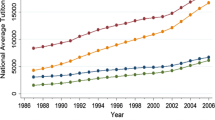Abstract
In this paper, the relationship between the economic growth in the states of Mexico (EGM) and the number of colleges and universities (NU) was estimated. In order to prove the existence of long-term association among the study variables, yearly data from 1995 to 2015 was used and a fixed-effects data panel model was calculated. Results show that a 100% increase in the number of public universities is positively and significantly related to a growth of 38.2% in the GDP per capita. Our evidence can potentially be useful for the design of public policies of higher education, especially in some countries as Mexico while there are not many studies in this regard.
Access this chapter
Tax calculation will be finalised at checkout
Purchases are for personal use only
Similar content being viewed by others
Notes
- 1.
Non-rivalrous goods are public goods that are consumed by people but whose supply is not affected by people’s consumption. The education and the knowledge are non-rivalrous goods; once something is known it is in principle available to all at very low cost and should be organized so that it is [19].
- 2.
For more information, visit: http://www.execum.unam.mx/.
Execum is a data explorer of the comparative study of the Mexican universities of the UNAM (2018).
National Autonomous University of Mexico (UNAM, by its acronym in Spanish).
- 3.
The National Institute of Statistics and Geography (INEGI, by its acronym in Spanish). It is one of Mexico's autonomous constitutional institutions with its own management, legal personality and assets, responsible for regulating and coordinating the National System of Statistical Information and Geography [9].
For further information on the databases, visit: https://www.inegi.org.mx/.
- 4.
The INPC, by its acronym in Spanish, is a global economic indicator whose purpose is to measure, over time, the variation in prices of a basket of goods and services representative of the consumption of the country's households. The INPC has become one of the main indicators of the country's economic performance; its applications are numerous and of great importance in the economic, legal and social fields.
References
Arteaga C (2018) The effect of human capital on earnings: evidence from a reform at Colombia’s top university. J Public Econ 157:212–225. https://doi.org/10.1016/j.jpubeco.2017.10.007
Barceinas Paredes F (2001) Capital Humano y Rendimientos de la Educación en México. Universitat Autònoma de Barcelona. https://www.tesisenred.net/handle/10803/3983#page=17
Benhabib J, Spiegel MM (1994) The role of human capital in economic development evidence from aggregate cross-country data. J Monet Econ 34(2):143–173. https://doi.org/10.1016/0304-3932(94)90047-7
Caplan B (2018) The case against education why the education system is a waste of time and money. Radical Teacher Princeton University Press, New Jersey
Demeulemeester JL, Diebolt C (2011) Education and growth: what links for which policy? Hist Soc Res 36(4):323–346. https://doi.org/10.12759/hsr.36.2011.4.323-346
Execum (2021) Execum: Estudio Comparativo de Universidades Mexicanas. http://www.execum.unam.mx/
Gujarati DN, Porter DC (2013) Econometría. In: Zúñiga Gutiérrez EC (ed) Quinta. Ciudad de México, McGraw-Hill
Hausman N (2012) University innovation, local economic growth, and entrepreneurship. US Census Bur Cent Econ Stud 12(10):48. https://doi.org/10.2139/ssrn.2097842
INEGI (2021) Instituto Nacional de Estadística y Geografía
Lomelí Vanegas L (2020) Educación superior y desarrollo: los desafíos de México. Economía UNAM 16(47):3–11. http://www.scielo.org.mx/scielo.php?script=sci_arttext&pid=S1665-952X2019000200003&lang=pt%0Ahttp://www.scielo.org.mx/pdf/eunam/v16n47/1665-952X-eunam-16-47-3.pdf
Lucas RE (1988) On the mechanics of economic development. J Monet Econ 3–42. https://www.parisschoolofeconomics.eu/docs/darcillon-thibault/lucasmechanicseconomicgrowth.pdf
Mungaray Lagarda A, Torres Preciado V (2010) Actividad económica y educación superior en México. Revista de La Educación Superior 39(156):7–18
Ríos Flores JA, Ocegueda Hernández JM (2017) Capacidad innovadora y crecimiento regional en México: un enfoque espacial. Econ Soc Y Territ xvii(1):743. https://doi.org/10.22136/est2017705
Sanyal BC, Martin M (2006) La financiación de la educación superior: perspectivas internacionales. In: Mundiprensa (ed) Informe: La educación superior en el mundo 2006 : La financiación de las universidades. Barcelona: Universidad Politécnica de Cataluña, pp 3–17. https://upcommons.upc.edu/handle/2099/5823
Torres T, Enciso P, Farré M, Sala M (2010) El impacto de la universidad en el ámbito económico y del conocimiento. El caso de la universidad de lleida. RegNal Sect Econ Stud 10(3):174–199. http://www.usc.es/economet/reviews/eers10310.pdf
Valero A, Van Reenen J (2018) The economic impact of universities: evidence from across the globe. Econ Educ Rev 68:53–67. doi:https://doi.org/10.1016/j.econedurev.2018.09.001
Vandenbussche J, Aghion P, Meghir C (2006) Growth, distance to frontier and composition of human capital. J Econ Growth 11(2):97–127. https://doi.org/10.1007/s10887-006-9002-y
Villarreal Peralta EM (2018) Endogeneidad de los rendimientos educativos en México. PerfEs Latinoam 26(51):265–299. https://doi.org/10.18504/pl2651-011-2018
Williams G (2016) Higher education: public good or private commodity? Lond Rev Educ 14(1):131–142. https://doi.org/10.18546/LRE.14.1.12
Author information
Authors and Affiliations
Corresponding author
Editor information
Editors and Affiliations
Rights and permissions
Copyright information
© 2022 The Author(s), under exclusive license to Springer Nature Switzerland AG
About this chapter
Cite this chapter
Kido-Cruz, A., Luna-Campos, F.A. (2022). Economic Growth and Universities: Empirical Evidence for Mexico. In: León-Castro, E., Blanco-Mesa, F., Alfaro-García, V., Gil-Lafuente, A.M., Merigó, J.M., Kacprzyk, J. (eds) Soft Computing and Fuzzy Methodologies in Innovation Management and Sustainability. Lecture Notes in Networks and Systems, vol 337. Springer, Cham. https://doi.org/10.1007/978-3-030-96150-3_10
Download citation
DOI: https://doi.org/10.1007/978-3-030-96150-3_10
Published:
Publisher Name: Springer, Cham
Print ISBN: 978-3-030-96149-7
Online ISBN: 978-3-030-96150-3
eBook Packages: Intelligent Technologies and RoboticsIntelligent Technologies and Robotics (R0)




